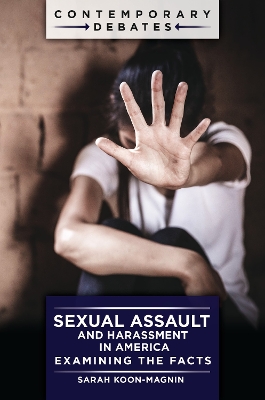Sexual Assault and Harassment in America
 portes grátis
portes grátis
Sexual Assault and Harassment in America
Examining the Facts
Koon-Magnin, Sarah
Bloomsbury Publishing Plc
05/2022
216
Dura
Inglês
9781440876554
15 a 20 dias
Descrição não disponível.
Introduction
Chapter 1. Sexual assault in the United States: What we know and how we know it
Q1. Is there a single definition of sexual assault?
Q2. Is there a single agreed-upon measure of sexual assault in the United States?
Q3. Do all states define consent in the same way?
Q4. Is sexual assault a big problem in the United States?
Q5. Are all forms of sexual assault treated equally seriously by the criminal justice system?
Chapter 2. Demographic differences in sexual assault victimization
Q6. Are all people at equal risk of being sexually assaulted?
Q7. Can men be sexually assaulted?
Q8. Are there differences in risk and experience of sexual assault victimization by age?
Q9. Is the risk of sexual assault victimization greater for people with certain sexual orientations or gender identities?
Q10. Do other factors impact the risk of sexual assault victimization or perpetration?
Chapter 3. Reporting sexual assault
Q11. Do most victims report sexual assaults to law enforcement?
Q12. Do inconsistencies in victims' statements to police mean that their claims are false or exaggerated?
Q13. If a claim of sexual assault does not result in an arrest, does that mean the assault did not happen?
Q14. Are false reports of sexual assault a common problem in the United States?
Q15. Can a sexual assault forensic exam ("rape kit") prove whether someone was raped?
Chapter 4. The impact of sexual assault on victims
Q16. Is someone who is sexually assaulted likely to suffer negative mental health consequences?
Q17. Does the reaction that someone receives following a disclosure of sexual assault impact the recovery process?
Q18. Are most victims of sexual assault physically injured?
Q19. Is "victim blaming" a problem in the United States?
Q20. Do rape myths impact sexual assault survivors?
Q21. Has the MeToo movement had an effect on sexual assault survivors?
Chapter 5. Government and criminal justice responses to sexual assault victims
Q22. Has the Violence Against Women Act (VAWA) helped victims of sexual assault?
Q23. Are steps being taken to address the "rape kit backlog"?
Q24. Are there steps that law enforcement can take to better respond to sexual assaults?
Q25. Are there steps that prosecutors can take to better respond to sexual assault victims?
Q26. Are sexual assault response teams (SARTs) an effective method of addressing the problem of sexual assault?
Chapter 6. Government and criminal justice responses to sexual offenders
Q27. Do most sex offenders go to prison?
Q28. Do most convicted sex offenders serve time in jail or prison?
Q29. Do all sex offenders reoffend?
Q30. Are sex offender registries effective public safety tools?
Chapter 7. Prevention and response services outside of the criminal justice system
Q31. Are there professionals outside of the criminal justice system who can help victims following a sexual assault?
Q32. Do SANE programs improve outcomes for sexual assault victims?
Q33. Do trauma-informed practices help victims of sexual assault?
Q34. Does Title IX apply to sexual misconduct at institutions of higher education?
Index
Chapter 1. Sexual assault in the United States: What we know and how we know it
Q1. Is there a single definition of sexual assault?
Q2. Is there a single agreed-upon measure of sexual assault in the United States?
Q3. Do all states define consent in the same way?
Q4. Is sexual assault a big problem in the United States?
Q5. Are all forms of sexual assault treated equally seriously by the criminal justice system?
Chapter 2. Demographic differences in sexual assault victimization
Q6. Are all people at equal risk of being sexually assaulted?
Q7. Can men be sexually assaulted?
Q8. Are there differences in risk and experience of sexual assault victimization by age?
Q9. Is the risk of sexual assault victimization greater for people with certain sexual orientations or gender identities?
Q10. Do other factors impact the risk of sexual assault victimization or perpetration?
Chapter 3. Reporting sexual assault
Q11. Do most victims report sexual assaults to law enforcement?
Q12. Do inconsistencies in victims' statements to police mean that their claims are false or exaggerated?
Q13. If a claim of sexual assault does not result in an arrest, does that mean the assault did not happen?
Q14. Are false reports of sexual assault a common problem in the United States?
Q15. Can a sexual assault forensic exam ("rape kit") prove whether someone was raped?
Chapter 4. The impact of sexual assault on victims
Q16. Is someone who is sexually assaulted likely to suffer negative mental health consequences?
Q17. Does the reaction that someone receives following a disclosure of sexual assault impact the recovery process?
Q18. Are most victims of sexual assault physically injured?
Q19. Is "victim blaming" a problem in the United States?
Q20. Do rape myths impact sexual assault survivors?
Q21. Has the MeToo movement had an effect on sexual assault survivors?
Chapter 5. Government and criminal justice responses to sexual assault victims
Q22. Has the Violence Against Women Act (VAWA) helped victims of sexual assault?
Q23. Are steps being taken to address the "rape kit backlog"?
Q24. Are there steps that law enforcement can take to better respond to sexual assaults?
Q25. Are there steps that prosecutors can take to better respond to sexual assault victims?
Q26. Are sexual assault response teams (SARTs) an effective method of addressing the problem of sexual assault?
Chapter 6. Government and criminal justice responses to sexual offenders
Q27. Do most sex offenders go to prison?
Q28. Do most convicted sex offenders serve time in jail or prison?
Q29. Do all sex offenders reoffend?
Q30. Are sex offender registries effective public safety tools?
Chapter 7. Prevention and response services outside of the criminal justice system
Q31. Are there professionals outside of the criminal justice system who can help victims following a sexual assault?
Q32. Do SANE programs improve outcomes for sexual assault victims?
Q33. Do trauma-informed practices help victims of sexual assault?
Q34. Does Title IX apply to sexual misconduct at institutions of higher education?
Index
Este título pertence ao(s) assunto(s) indicados(s). Para ver outros títulos clique no assunto desejado.
Child Abuse; Crime; Criminal Justice System; Female Victims of Sexual Violence; Law Enforcement; LGBTQ+ Victims of Sexual Violence; Male Victims of Sexual Violence; Misogyny; Online Harassment; Prison Rape; Rape; Rape Culture; Rape Kits; Sex Crime Investigations; Sex Crimes; Sexism; Sexual Assault; Sexual Harassment; Sexual Offenders; Victim-Blaming; Victims Services
Introduction
Chapter 1. Sexual assault in the United States: What we know and how we know it
Q1. Is there a single definition of sexual assault?
Q2. Is there a single agreed-upon measure of sexual assault in the United States?
Q3. Do all states define consent in the same way?
Q4. Is sexual assault a big problem in the United States?
Q5. Are all forms of sexual assault treated equally seriously by the criminal justice system?
Chapter 2. Demographic differences in sexual assault victimization
Q6. Are all people at equal risk of being sexually assaulted?
Q7. Can men be sexually assaulted?
Q8. Are there differences in risk and experience of sexual assault victimization by age?
Q9. Is the risk of sexual assault victimization greater for people with certain sexual orientations or gender identities?
Q10. Do other factors impact the risk of sexual assault victimization or perpetration?
Chapter 3. Reporting sexual assault
Q11. Do most victims report sexual assaults to law enforcement?
Q12. Do inconsistencies in victims' statements to police mean that their claims are false or exaggerated?
Q13. If a claim of sexual assault does not result in an arrest, does that mean the assault did not happen?
Q14. Are false reports of sexual assault a common problem in the United States?
Q15. Can a sexual assault forensic exam ("rape kit") prove whether someone was raped?
Chapter 4. The impact of sexual assault on victims
Q16. Is someone who is sexually assaulted likely to suffer negative mental health consequences?
Q17. Does the reaction that someone receives following a disclosure of sexual assault impact the recovery process?
Q18. Are most victims of sexual assault physically injured?
Q19. Is "victim blaming" a problem in the United States?
Q20. Do rape myths impact sexual assault survivors?
Q21. Has the MeToo movement had an effect on sexual assault survivors?
Chapter 5. Government and criminal justice responses to sexual assault victims
Q22. Has the Violence Against Women Act (VAWA) helped victims of sexual assault?
Q23. Are steps being taken to address the "rape kit backlog"?
Q24. Are there steps that law enforcement can take to better respond to sexual assaults?
Q25. Are there steps that prosecutors can take to better respond to sexual assault victims?
Q26. Are sexual assault response teams (SARTs) an effective method of addressing the problem of sexual assault?
Chapter 6. Government and criminal justice responses to sexual offenders
Q27. Do most sex offenders go to prison?
Q28. Do most convicted sex offenders serve time in jail or prison?
Q29. Do all sex offenders reoffend?
Q30. Are sex offender registries effective public safety tools?
Chapter 7. Prevention and response services outside of the criminal justice system
Q31. Are there professionals outside of the criminal justice system who can help victims following a sexual assault?
Q32. Do SANE programs improve outcomes for sexual assault victims?
Q33. Do trauma-informed practices help victims of sexual assault?
Q34. Does Title IX apply to sexual misconduct at institutions of higher education?
Index
Chapter 1. Sexual assault in the United States: What we know and how we know it
Q1. Is there a single definition of sexual assault?
Q2. Is there a single agreed-upon measure of sexual assault in the United States?
Q3. Do all states define consent in the same way?
Q4. Is sexual assault a big problem in the United States?
Q5. Are all forms of sexual assault treated equally seriously by the criminal justice system?
Chapter 2. Demographic differences in sexual assault victimization
Q6. Are all people at equal risk of being sexually assaulted?
Q7. Can men be sexually assaulted?
Q8. Are there differences in risk and experience of sexual assault victimization by age?
Q9. Is the risk of sexual assault victimization greater for people with certain sexual orientations or gender identities?
Q10. Do other factors impact the risk of sexual assault victimization or perpetration?
Chapter 3. Reporting sexual assault
Q11. Do most victims report sexual assaults to law enforcement?
Q12. Do inconsistencies in victims' statements to police mean that their claims are false or exaggerated?
Q13. If a claim of sexual assault does not result in an arrest, does that mean the assault did not happen?
Q14. Are false reports of sexual assault a common problem in the United States?
Q15. Can a sexual assault forensic exam ("rape kit") prove whether someone was raped?
Chapter 4. The impact of sexual assault on victims
Q16. Is someone who is sexually assaulted likely to suffer negative mental health consequences?
Q17. Does the reaction that someone receives following a disclosure of sexual assault impact the recovery process?
Q18. Are most victims of sexual assault physically injured?
Q19. Is "victim blaming" a problem in the United States?
Q20. Do rape myths impact sexual assault survivors?
Q21. Has the MeToo movement had an effect on sexual assault survivors?
Chapter 5. Government and criminal justice responses to sexual assault victims
Q22. Has the Violence Against Women Act (VAWA) helped victims of sexual assault?
Q23. Are steps being taken to address the "rape kit backlog"?
Q24. Are there steps that law enforcement can take to better respond to sexual assaults?
Q25. Are there steps that prosecutors can take to better respond to sexual assault victims?
Q26. Are sexual assault response teams (SARTs) an effective method of addressing the problem of sexual assault?
Chapter 6. Government and criminal justice responses to sexual offenders
Q27. Do most sex offenders go to prison?
Q28. Do most convicted sex offenders serve time in jail or prison?
Q29. Do all sex offenders reoffend?
Q30. Are sex offender registries effective public safety tools?
Chapter 7. Prevention and response services outside of the criminal justice system
Q31. Are there professionals outside of the criminal justice system who can help victims following a sexual assault?
Q32. Do SANE programs improve outcomes for sexual assault victims?
Q33. Do trauma-informed practices help victims of sexual assault?
Q34. Does Title IX apply to sexual misconduct at institutions of higher education?
Index
Este título pertence ao(s) assunto(s) indicados(s). Para ver outros títulos clique no assunto desejado.
Child Abuse; Crime; Criminal Justice System; Female Victims of Sexual Violence; Law Enforcement; LGBTQ+ Victims of Sexual Violence; Male Victims of Sexual Violence; Misogyny; Online Harassment; Prison Rape; Rape; Rape Culture; Rape Kits; Sex Crime Investigations; Sex Crimes; Sexism; Sexual Assault; Sexual Harassment; Sexual Offenders; Victim-Blaming; Victims Services







